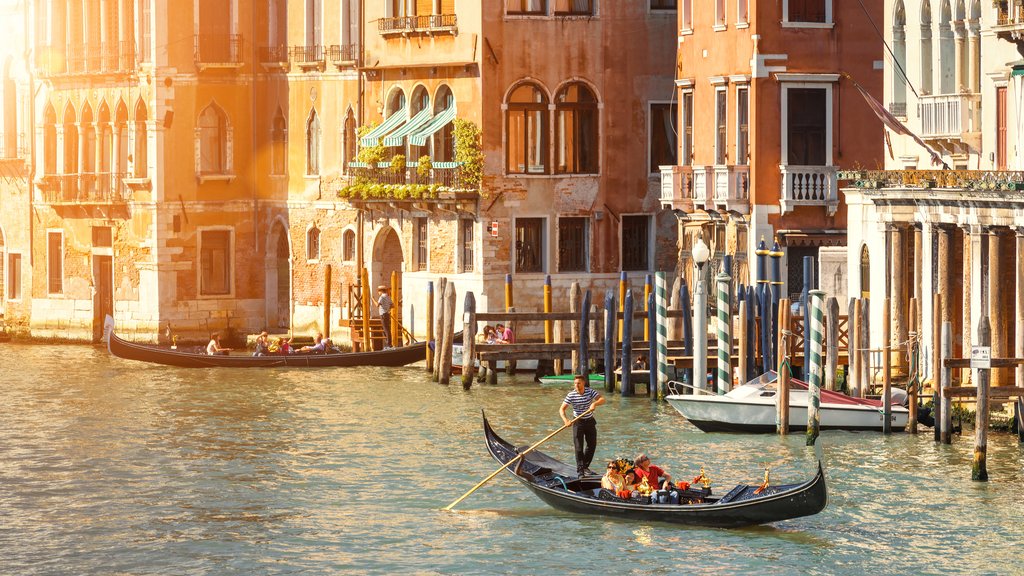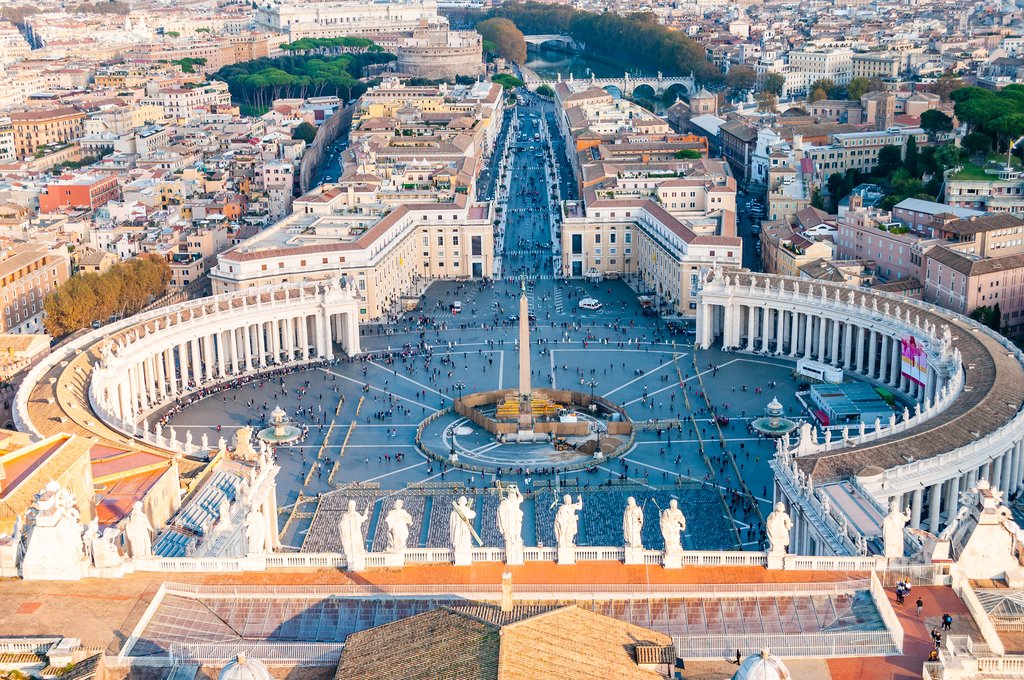Highlights
- Ride a gondola along the Grand Canal, one of Venice's major waterways
- See masterpieces by Michelangelo and da Vinci in the Uffizi Gallery
- Visit the Vatican Museum, Sistine Chapel, and Galleria Borghese in Rome
- Enjoy wine tasting in the Chianti Classico region of Tuscany
Brief Itinerary
| Day | Highlights | Overnight |
|---|---|---|
| Day 1 | Arrive in Rome, Train to Venice | Venice |
| Day 2 | Venice Walking Tour | Venice |
| Day 3 | Train to Florence, Food Tour | Florence |
| Day 4 | Tour of Tuscany & Wine Tasting | Florence |
| Day 5 | Train to Rome, Colosseum & Forum Tour | Rome |
| Day 6 | Vatican & Classic Tour of Rome | Rome |
| Day 7 | Depart Rome |
Detailed Itinerary
Day 1: Arrive in Rome, Train to Venice

Welcome to Italy! Arrive at one of Rome's two international airports, then transfer to the Roma Termini Station for a ride on the high-speed train en route to Venice. Once in the city, a water taxi will transport you to the town center and your hotel. Venice in northern Italy is famous for both industry and tourism. With nicknames like "Queen of the Adriatic," "City of Water," and "The Floating City," it's clear that the city's myriad canals are its main draw. Stretching across 117 small islands in the marshy Venetian Lagoon along the Adriatic Sea, the city has long been a commercial and cultural hub thanks to its strategic placement. Silk, grains, spices, and art were traded through the Middle Ages, making Venice very wealthy.
Venice is well known for several artistic movements, particularly from the Renaissance period. The city's many musicians, like Antonio Vivaldi and others, played important roles in the shaping of symphonic and operatic music. Numerous artists have called Venice home, and their work continues to draw visitors worldwide. The city is also famous for its many beautiful historical attractions, such as the Piazza San Marco and San Marco Basilica, the Grand Canal, and the ornate Doge's Palace. The Lido de Venezia is a popular luxury destination that attracts actors, critics, and other cinema industry celebrities.
Depending on when you arrive, a great introduction to the city is to take a romantic cruise down Venice's canals on a historic gondola to see stunning architecture and narrow waterways. This is not a guided tour but rather a relaxing cruise that allows you to take in the amazing city from the water.
In the evening, head to the Cannaregio District, the site of the former Jewish Ghetto, for a walking food tour. The area is filled with restaurants & shops offering kosher Venetian specialties, a Jewish museum, and several tourist-friendly synagogues. Eat and drink your way through regional specialties as you learn about the Jewish and Kosher influences and sample Cicchetti, creamy risottos, and sweet pastries and local wines. Buon appetito!
Day 2: Venice Walking Tour

Experience Venice's highlights with a guided walking tour. Start at Piazza San Marco (St. Mark's Square), the heart of the city's cultural and administrative district. Tour Palazzo Ducale (Doge's Palace), a Venetian Gothic palace built as the primary residence for the Doge of Venice in 1340. The palace stands on Piazza San Marco, and its resplendent interior decor and priceless works of art make it a must-see for history and architecture buffs.
Adjacent to the palace is San Marco's Basilica, originally the Doge's personal chapel. The building is one of the best surviving examples of Italo-Byzantine architecture and features a stunning collection of Byzantine art, gold mosaics, and exquisite marble floors. The palace is also connected to the next-door prison by the infamous Bridge of Sighs, which has joined the two buildings since the 16th century. The bridge features a small window onto Venice's harbor and earned its grisly name from the prisoners' sighing as they got one last glimpse of the city on their way to execution. While most visitors gather outside the bridge to look in, you'll get the best sense of history from inside the bridge, looking out from the same window as the doomed medieval prisoners.
After the morning's tour, grab lunch at one of the city's many cafés before spending the afternoon exploring.
- Tour the 18th-century Chiesa di Santa Maria Assunta (also known as I Gesuiti) in the Cannaregio district and the Baroque 17th-century Basilica di Santa Maria della Salute, Venice's second most renowned church
- Ride the elevator to the top of the Campanile di San Marco for a bird's-eye view of Venice
- Dive into history at the Correr Civic Museum to see art and artifacts displays from Venice's history as well as the former royals' quarters
- Go shopping at the famous Rialto fish market, located at the heart of Venice. The smell of seafood and the sound of vendors vying for shoppers' attention make this colorful and hectic market a must-see for any Venice traveler
In the evening, rent a bike and go for a relaxed bike ride around the city before finding the best bars and nightlife for a night out.
Day 3: Train to Florence, Food Tour

After breakfast, head to the train station to catch a train to Florence. Florence is Tuscany's regional capital and its most populous city. Long considered a cultural capital and the "Jewel of the Renaissance," Florence is home to many masterpieces of Renaissance art and architecture, including the iconic Duomo, a terracotta-tiled dome, and the Galleria dell'Accademia, which displays Michelangelo's "David" sculpture.
Spend the day exploring the top sites located in the medieval city center. Popular highlights include the sprawling 15th-century Pitti Palace and the world-famous Uffizi Gallery, which houses work by artists like Michelangelo and Leonardo de Vinci. As a center for art, Florence has hosted many of European history's most notable figures, including Botticelli, Donatello, Dante, Boccaccio, and Niccolò Machiavelli.
In the afternoon, indulge yourself in the decadence of Tuscany's culinary delights. A guided walking tour of the city led by a local is the perfect way to discover the region's history and find the best off-the-beaten-path gelato and coffee shops. Sample wares from city markets to find the best of the best. Try truffle panini, fresh-pressed Tuscan olive oil, and handmade chocolate focaccia, finished with a glass of chilled prosecco or Chianti wine.
Chat with a local specialist who can help organize your trip.
Day 4: Tour of Tuscany & Wine Tasting

In the morning, head to the Tuscan countryside to explore the Chianti Region. Your first stop is the medieval village of San Gimignano, a UNESCO World Heritage Site located an hour away from Florence, which is famous for its Vernaccia wine and award-winning gelaterias. Explore the beautiful squares, palaces, and churches of the city before grabbing a coffee in an open-air café.
Continue to the Chianti Classico wine region to visit a typical Tuscan winery. The unique characteristics of the local climate have made the region unfavorable to most crops but ideal for growing wine grapes. Alternating fields of olive orchards and vineyards characterize this idyllic landscape. The Chianti wine, made primarily of Sangiovese grapes, is the local staple. Tour the cellars and vineyards, then enjoy a wine tasting accompanied by a delicious Tuscan lunch of pasta, cured meats, cheeses, and local desserts.
In the afternoon, visit nearby Siena, located a scenic hourlong drive away, to see the magnificent Cathedral, Torre del Mangia, and Town Hall, the site of the famous Palio horse race. Finish the day with a visit to the medieval fortress of Monteriggioni before returning to Florence for the night.
Day 5: Train to Rome, Colosseum & Forum Tour

After a relaxing breakfast, it's time to say goodbye to Florence. Catch a high-speed train back to Rome, then check in to your hotel. According to legend, Rome was founded by brothers Romulus and Remus in 753 BCE atop Rome's Palatine Hill. The long-time center of the powerful Roman Empire, Rome boasts nearly 3,000 years of architecture, history, and culture. These days, Italy's capital is considered one of Europe's top cities thanks to its ancient monuments, incredible art masterpieces, and cosmopolitan vibe. It's a center for fashion with a buzzing food culture and has a growing nightlife scene.
Visitors and locals wanting to soak in the sunshine flock to the beautiful Giardino degli Aranci, the city's vibrant orange tree gardens on Aventine Hill, or relax in the lush greenery of the Villa Borghese Gardens.
In the afternoon, dive into the history of the Roman Empire with a walking tour of the Colosseum, the world's largest amphitheater (tickets included). Walking through the ancient amphitheater is like taking a trip back in time to the days of the Roman Empire. Learn about some of ancient Rome's most famous and illustrious citizens, such as Julius Caesar, Emperors Augustus and Nero, and the Flavian Emperors who built the Colosseum.
After a tour of the archaeological area, continue to the Roman Forum and Palatine Hill. From here, walk along the ancient Roman street Via Sacra to see the Temples of Vesta, Antonino, and Faustina. See the ancient Basilica Julia and Aemilia and experience the grandeur of the Roman Empire.
Day 6: Vatican & Classic Tour of Rome

Today you will visit the Vatican City museums and Sistine Chapel, as well as other top sights, for an exclusive six-hour tour of the city's incredible art and history. Start at the Vatican, where you'll visit the Pio Clementio Museum, Gallery of the Candelabra, Gallery of Tapestries, and Gallery of the Geographical Maps. Continue to see the magnificent Raphael's Rooms, ending in the breathtaking Sistine Chapel and St. Peter's Basilica. Experience the magic of Renaissance art as you learn about the secret details and untold stories of the masterpieces.
Afterward, continue into a city for a tour of the city's most notable landmarks. Cross Piazza della Repubblica to see the Fountain of the Nyands, then continue to see the Trevi Fountain, La Colonna di Marco Aurelio, and the Palazzo di Montecitorio, which was designed by Bernini. Admire the exterior of the Pantheon and head inside for a look at the ancient Roman temple, then head to Palazzo Madama—the Senate seat—ending at Piazza Navona.
End your evening with a stroll to the neighborhood piazza for gelato and some people-watching.
Day 7: Depart Rome

Time to say goodbye to the country of love! After one last cappuccino over breakfast, head to the airport for your connecting flight home. Safe travels!
More Great Italy Itineraries
Looking for more inspiration for your trip to Italy? Check out these other Italy itineraries, explore different ways to spend a week in Italy, or discover the best time to visit Italy.








